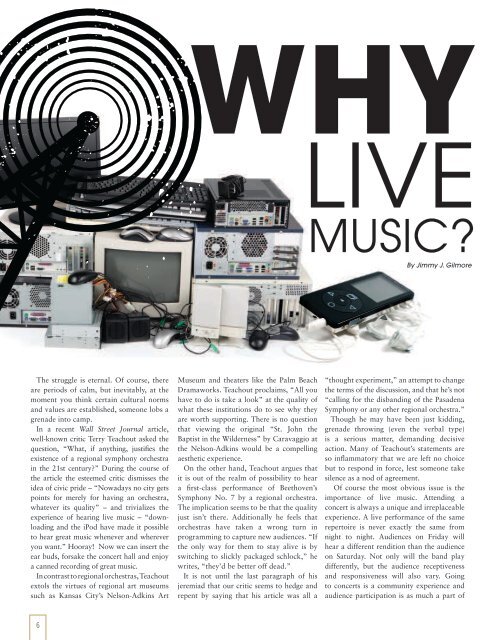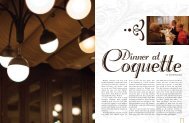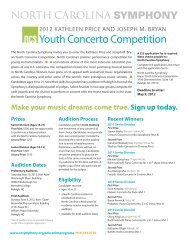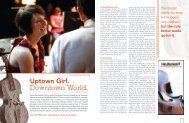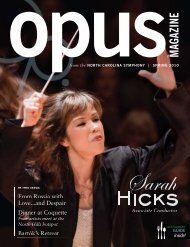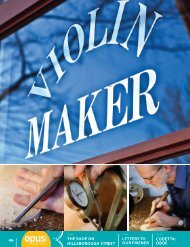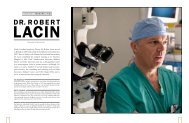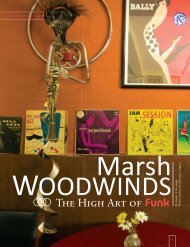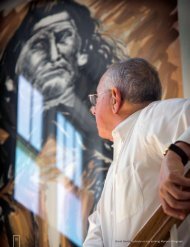Opus magazine - North Carolina Symphony
Opus magazine - North Carolina Symphony
Opus magazine - North Carolina Symphony
- No tags were found...
Create successful ePaper yourself
Turn your PDF publications into a flip-book with our unique Google optimized e-Paper software.
The struggle is eternal. Of course, there<br />
are periods of calm, but inevitably, at the<br />
moment you think certain cultural norms<br />
and values are established, someone lobs a<br />
grenade into camp.<br />
In a recent Wall Street Journal article,<br />
well-known critic Terry Teachout asked the<br />
question, “What, if anything, justifies the<br />
existence of a regional symphony orchestra<br />
in the 21st century” During the course of<br />
the article the esteemed critic dismisses the<br />
idea of civic pride – “Nowadays no city gets<br />
points for merely for having an orchestra,<br />
whatever its quality” – and trivializes the<br />
experience of hearing live music – “downloading<br />
and the iPod have made it possible<br />
to hear great music whenever and wherever<br />
you want.” Hooray! Now we can insert the<br />
ear buds, forsake the concert hall and enjoy<br />
a canned recording of great music.<br />
In contrast to regional orchestras, Teachout<br />
extols the virtues of regional art museums<br />
such as Kansas City’s Nelson-Adkins Art<br />
WHY<br />
LIVE<br />
music<br />
By Jimmy J. Gilmore<br />
Museum and theaters like the Palm Beach<br />
Dramaworks. Teachout proclaims, “All you<br />
have to do is take a look” at the quality of<br />
what these institutions do to see why they<br />
are worth supporting. There is no question<br />
that viewing the original “St. John the<br />
Baptist in the Wilderness” by Caravaggio at<br />
the Nelson-Adkins would be a compelling<br />
aesthetic experience.<br />
On the other hand, Teachout argues that<br />
it is out of the realm of possibility to hear<br />
a first-class performance of Beethoven’s<br />
<strong>Symphony</strong> No. 7 by a regional orchestra.<br />
The implication seems to be that the quality<br />
just isn’t there. Additionally he feels that<br />
orchestras have taken a wrong turn in<br />
programming to capture new audiences. “If<br />
the only way for them to stay alive is by<br />
switching to slickly packaged schlock,” he<br />
writes, “they’d be better off dead.”<br />
It is not until the last paragraph of his<br />
jeremiad that our critic seems to hedge and<br />
repent by saying that his article was all a<br />
“thought experiment,” an attempt to change<br />
the terms of the discussion, and that he’s not<br />
“calling for the disbanding of the Pasadena<br />
<strong>Symphony</strong> or any other regional orchestra.”<br />
Though he may have been just kidding,<br />
grenade throwing (even the verbal type)<br />
is a serious matter, demanding decisive<br />
action. Many of Teachout’s statements are<br />
so inflammatory that we are left no choice<br />
but to respond in force, lest someone take<br />
silence as a nod of agreement.<br />
Of course the most obvious issue is the<br />
importance of live music. Attending a<br />
concert is always a unique and irreplaceable<br />
experience. A live performance of the same<br />
repertoire is never exactly the same from<br />
night to night. Audiences on Friday will<br />
hear a different rendition than the audience<br />
on Saturday. Not only will the band play<br />
differently, but the audience receptiveness<br />
and responsiveness will also vary. Going<br />
to concerts is a community experience and<br />
audience participation is as much a part of<br />
music making as playing the notes on the<br />
page. Sorry, but a recording on any device<br />
will never be the same as hearing music live.<br />
Listening to a great recording is worthwhile,<br />
but because the performance is frozen in time,<br />
it is often a solitary, predictable experience,<br />
lacking spontaneity. I have many great<br />
recordings in my library. Some are of live<br />
performances. One of the most notable is<br />
that famous rendition of Scheherazade with<br />
the Chicago <strong>Symphony</strong> conducted by Fritz<br />
Reiner, which was recorded in a single take! I<br />
am always thrilled to listen to it, but it is still a<br />
recording, and I always know what’s coming.<br />
Then there is the sound. It should tell<br />
us something when engineers spend their<br />
lives trying to make recordings sound like a<br />
performance in a great concert hall. Regardless<br />
the technology, capturing the full spectrum<br />
of sound and the wide dynamic range one<br />
encounters in classical music remains a<br />
conundrum for the recording industry.<br />
Ironically, our advanced technology has<br />
led to less fidelity in recordings now than<br />
in years past. In a recent New York Times<br />
article Joseph Plambeck wrote, “the ease<br />
of loading songs onto a computer or an<br />
iPod has meant that a generation of fans<br />
has happily traded fidelity for portability<br />
and convenience.” That Reiner recording<br />
referred to earlier was made fifty years<br />
ago, in 1960. In the opinion of many<br />
musicians and audiophiles, this was an<br />
era of unsurpassed sonic excellence in the<br />
recording industry. The technology wasn’t<br />
as stunning in 1960 as it is today, but the<br />
results were superior.<br />
Teachout seems to abandon his own<br />
logic in talking about regional museums<br />
and theaters. If the iPod is a worthy<br />
replacement for attending a regional<br />
orchestra performance of Beethoven, then<br />
by the same logic why shouldn’t we simply<br />
download masterpieces of visual art to<br />
our computers<br />
It is painfully obvious that a work of<br />
art compressed on a computer screen will<br />
never equal viewing the real thing, just<br />
as squeezing Beethoven into a MP3 file<br />
will never have the spontaneity or sonic<br />
ambience of the concert hall. Of course it<br />
would be more convenient – I could stay<br />
at home, eat my moon pie and drink my<br />
beer (that’s fine cuisine to us down here<br />
in “Podunk”), listen to Beethoven on my<br />
iPod, and look at St. John on the computer<br />
all at the same time. And I could spare<br />
myself the time and cost of a trip to the<br />
Nelson-Adkins in Kansas City.<br />
Programming for orchestras is always<br />
a sticky wicket and Teachout rightfully<br />
refuses to embrace the idea of “slickly packaged<br />
schlock” as a solution to capturing audiences.<br />
However, he exaggerates his point. The<br />
bedrock of the orchestra repertory will always<br />
remain the great masterpieces beginning<br />
with Haydn, Mozart and Beethoven. This is<br />
because the symphony orchestra, like the<br />
piano, is essentially a 19 th century instrument.<br />
In an effort to reach a broader public,<br />
orchestras, like museums and theater companies,<br />
try to appeal to a variety of tastes. The<br />
schlock to which Teachout refers generally<br />
falls under the broad category of “Pops.” Do<br />
we need to remind him that it was Arthur<br />
Fiedler and the Boston <strong>Symphony</strong> who<br />
pioneered the idea of Pops The last time I<br />
checked, the Boston Pops was still a treasured<br />
American institution. However, some would<br />
consider much of what the Boston Pops plays,<br />
if not schlock, to be music of little substance.<br />
Still there are millions who love listening to<br />
the Pops and enjoying a less stuffy atmosphere<br />
in the concert hall.<br />
Several questions arise concerning museums<br />
and theaters, those institutions championed<br />
in the article as worthy of local support compared<br />
with regional orchestras.<br />
Aren’t there many artworks in the<br />
museum, local or otherwise, that most folks<br />
think outlandish and incomprehensible<br />
Yes!<br />
Are all the works in the Nelson-Adkins<br />
Museum the equal of St. John the Baptist<br />
No!<br />
Is it possible that some works in a given<br />
museum be considered schlock<br />
Definitely.<br />
As wonderful as the Nelson-Adkins<br />
may be, would it ever be confused with<br />
the Metropolitan Museum any more than<br />
the Pasadena <strong>Symphony</strong> be mistaken for<br />
the New York Philharmonic<br />
I think not.<br />
Museums and theaters present (and indeed<br />
it could be argued it is their duty to present)<br />
a wide variety of works encompassing the<br />
full range of artistic expression. Why is it<br />
permissible for museums and theaters to do<br />
so, and not orchestras<br />
Perhaps the most troubling notion<br />
expressed by Teachout is his dismissal of<br />
local pride in community orchestras. The<br />
idea that “no city gets points for merely<br />
having an orchestra, whatever its quality”<br />
indicates that Teachout assumes that the<br />
main reason for having an orchestra is to<br />
win approbation in a cultural race with<br />
other cities. Many of these ensembles have<br />
a long and rich cultural history and were<br />
created by people who simply yearned to<br />
hear great music. Not everyone can afford<br />
to go to Boston or New York when they get<br />
an itch to hear Beethoven.<br />
As to quality, anyone who knows the<br />
music business knows that the level of<br />
performance is at an all-time high across<br />
the board. So many excellent players<br />
are out there that a good performance<br />
It should tell us something when<br />
engineers spend their lives trying<br />
to make recordings sound like a<br />
performance in a great concert hall.<br />
by a regional orchestra of the standard<br />
repertoire is very likely to break out<br />
anytime at any location in the provinces.<br />
True, not every conductor is up to the task<br />
of leading his/her charges in a definitive<br />
interpretation, but you can pretty much bet<br />
that the technical execution will be there.<br />
Now we are left no choice but to tell Mr.<br />
Teachout where to go. To him I say, “Get<br />
thee to an elevator.” There you can ride up<br />
and down, push buttons and listen to canned<br />
music all day long. You can even pretend<br />
that you are at a live performance enjoying<br />
the music with your companions as you go<br />
from floor to floor. When you get tired of all<br />
this, come on down and give us a listen. I<br />
guarantee you’ll be pleasantly surprised.<br />
6<br />
7


